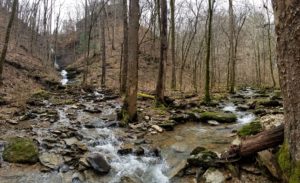Photo Credit: Kristen Hanratty
Jackson County
Hidden Springs
Project Partners
Aggie Black, Rose Black, Annie Black, Samuel Costilow
In 2013, Hector Black and his wife, Susie, partnered with TennGreen Land Conservancy to protect “Hidden Springs,” their 210-acre property near Cookeville, Tennessee. A decade later, in 2023, TennGreen worked with Aggie, Rose, and Annie Black—daughters of the late renowned activist Hector Black—and family friend Samuel Costilow to expand the Hidden Springs conservation easement. The amended easement protects an additional 54 acres, bringing the total land protected to more than 260 acres. It will also better reflect Hector Black’s wishes for the land, whose stories have garnered the attention of The New York Times, NPR, The Moth podcast, and more.
 Though the property remains privately owned, completing the conservation easement means its rich landscapes will be perpetually protected even if ownership changes. Hidden Springs abuts two miles of designated State Scenic River Spring Creek, and portions of the protected property are in the Roaring River-Blackburn Fork-Spring Creek Complex Area of Interest—as described by the Heritage Conservation Trust Fund’s 2007 plan. These waterways are Class I Natural Rivers, which means they’re free-flowing, unpolluted, “essentially primitive,” and generally accessible only by trail. Because many of Tennessee’s rivers and streams don’t meet federal water quality standards, the Hidden Springs conservation easement helps ensure that these Class I rivers remain pristine and safe. Furthermore, Hidden Springs is in a Conservation Opportunity Area in the State Wildlife Action Plan (SWAP), wherein there’s a need for more acres under permanent conservation management.
Though the property remains privately owned, completing the conservation easement means its rich landscapes will be perpetually protected even if ownership changes. Hidden Springs abuts two miles of designated State Scenic River Spring Creek, and portions of the protected property are in the Roaring River-Blackburn Fork-Spring Creek Complex Area of Interest—as described by the Heritage Conservation Trust Fund’s 2007 plan. These waterways are Class I Natural Rivers, which means they’re free-flowing, unpolluted, “essentially primitive,” and generally accessible only by trail. Because many of Tennessee’s rivers and streams don’t meet federal water quality standards, the Hidden Springs conservation easement helps ensure that these Class I rivers remain pristine and safe. Furthermore, Hidden Springs is in a Conservation Opportunity Area in the State Wildlife Action Plan (SWAP), wherein there’s a need for more acres under permanent conservation management.
The protected property has impressive geological features, including pinnacles: thin, tall columns of rock formed by erosion. The land is home to a variety of plants and animals, including butternut (Juglans cinerea)—a tree species with a “Vulnerable” to “Critically Impaired” conservation status. Individuals have also documented the hellbender, North America’s largest salamander, near Hidden Springs. The hellbender (Cryptobranchus alleganiensis) used to be common in Tennessee, but due to dams and pollution, the State lists it as “in need of management.” The Hidden Springs conservation easement helps prevent the hellbender from further decline.
Hidden Springs is also near other protected lands, further increasing the conservation easement’s importance. Protected lands within two miles include two publicly accessible areas—Blackburn Fork Wildlife Management Area (WMA) and Washmorgan Hollow State Natural Area (SNA)—and two privately owned properties: Circling Cranes and Spring Creek Cabin. TennGreen protects Blackburn Fork WMA, Circling Cranes, and Spring Creek Cabin with conservation easements. Hector & Susie Black donated Washmorgan Hollow SNA to the Nature Conservancy in 1986. Protected lands within five miles of Hidden Springs include Cummins Falls State Park, The Boils WMA, and Cordell Hull WMA.
TennGreen staff will monitor Hidden Springs annually to preserve Hector Black’s vision for the land in perpetuity.

